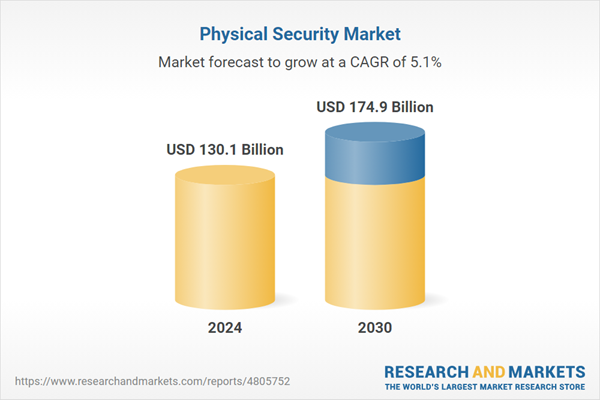The global market for Physical Security was valued at US$130.1 Billion in 2024 and is projected to reach US$174.9 Billion by 2030, growing at a CAGR of 5.1% from 2024 to 2030. This comprehensive report provides an in-depth analysis of market trends, drivers, and forecasts, helping you make informed business decisions. The report includes the most recent global tariff developments and how they impact the Physical Security market.
Segments: Component (Services, Systems); Organization Size (Large Enterprises, SMEs); End-Use (Government, Commercial, Residential, Utility, Other End-Uses).
Geographic Regions/Countries: World; United States; Canada; Japan; China; Europe (France; Germany; Italy; United Kingdom; and Rest of Europe); Asia-Pacific; Rest of World.
The analysts continuously track trade developments worldwide, drawing insights from leading global economists and over 200 industry and policy institutions, including think tanks, trade organizations, and national economic advisory bodies. This intelligence is integrated into forecasting models to provide timely, data-driven analysis of emerging risks and opportunities.
Global Physical Security Market - Key Trends and Drivers Summarized
Fortifying Spaces: The Evolving Landscape of Physical Security
Physical security refers to the measures designed to safeguard people, property, and information from physical threats such as theft, vandalism, natural disasters, and terrorism. Unlike cybersecurity, which protects digital assets, physical security focuses on tangible protections, including barriers, surveillance, and security personnel. Effective physical security systems integrate multiple layers of defenses, starting with perimeter security such as fences and gates, extending to interior protections like access control systems, alarms, and CCTV cameras. The primary objective is to deter potential threats, detect intrusions, and respond swiftly to any incidents. As organizations increasingly recognize the interconnectedness of physical and cyber threats, the importance of robust physical security measures cannot be overstated, ensuring the safety and continuity of operations in an ever-evolving threat landscape.How Are Modern Technologies Enhancing Physical Security Measures?
Modern physical security measures are significantly enhanced by the integration of advanced technologies, creating more robust and efficient protection systems. Video surveillance has evolved with high-definition cameras, thermal imaging, and facial recognition technology, allowing for real-time monitoring and precise identification of individuals. Access control systems have advanced from simple locks and keys to biometric systems that use fingerprints, iris scans, and facial recognition to grant or deny access. The Internet of Things (IoT) is revolutionizing physical security by connecting various security devices and systems, enabling centralized control and real-time data analysis. Drones are increasingly being used for perimeter surveillance, offering aerial views that complement ground-based security measures. Additionally, artificial intelligence (AI) and machine learning algorithms are being deployed to analyze security footage, detect anomalies, and predict potential security breaches before they occur. These technological advancements are not only enhancing the effectiveness of physical security measures but also providing new tools for proactive threat management.What Are the Current Trends and Challenges in Physical Security?
The field of physical security is continuously evolving, influenced by emerging trends and persistent challenges. One significant trend is the convergence of physical and cybersecurity, with integrated security systems that provide comprehensive protection against both physical and digital threats. There is also a growing emphasis on proactive security measures, using AI and predictive analytics to anticipate and mitigate potential risks. The deployment of smart sensors and IoT devices is enabling more sophisticated monitoring and control of security environments. However, these advancements also bring challenges, particularly concerning data privacy and the potential for cyber-attacks on physical security systems. Ensuring the interoperability of diverse security technologies and managing the vast amounts of data generated by modern security systems are also critical challenges. Additionally, the increasing sophistication of threats, including coordinated attacks and insider threats, requires continuous adaptation and innovation in security strategies. Balancing the need for robust security with user convenience and operational efficiency remains a key consideration for security professionals.What Factors Are Driving the Growth in the Physical Security Market?
The growth in the physical security market is driven by several factors, reflecting the increasing need for comprehensive security solutions across various sectors. Technological advancements, particularly in AI, IoT, and biometrics, are enhancing the capabilities and appeal of modern security systems. The rising incidence of security breaches, terrorism, and criminal activities is prompting organizations to invest in advanced physical security measures to protect their assets and personnel. Regulatory requirements and compliance standards are also driving market growth, as businesses and institutions strive to meet stringent security regulations. The expansion of smart city initiatives and the increasing adoption of connected devices are further propelling the demand for integrated security solutions. Additionally, the growing awareness of the importance of physical security in safeguarding critical infrastructure, including transportation hubs, power plants, and financial institutions, is contributing to market expansion. These factors, combined with the ongoing development of innovative security technologies, are ensuring robust growth in the physical security market, highlighting its critical role in protecting people, property, and information in a rapidly changing world.Report Scope
The report analyzes the Physical Security market, presented in terms of units. The analysis covers the key segments and geographic regions outlined below.Segments: Component (Services, Systems); Organization Size (Large Enterprises, SMEs); End-Use (Government, Commercial, Residential, Utility, Other End-Uses).
Geographic Regions/Countries: World; United States; Canada; Japan; China; Europe (France; Germany; Italy; United Kingdom; and Rest of Europe); Asia-Pacific; Rest of World.
Key Insights:
- Market Growth: Understand the significant growth trajectory of the Services segment, which is expected to reach US$106.9 Billion by 2030 with a CAGR of a 4.8%. The Systems segment is also set to grow at 5.5% CAGR over the analysis period.
- Regional Analysis: Gain insights into the U.S. market, valued at $35.5 Billion in 2024, and China, forecasted to grow at an impressive 4.7% CAGR to reach $27.4 Billion by 2030. Discover growth trends in other key regions, including Japan, Canada, Germany, and the Asia-Pacific.
Why You Should Buy This Report:
- Detailed Market Analysis: Access a thorough analysis of the Global Physical Security Market, covering all major geographic regions and market segments.
- Competitive Insights: Get an overview of the competitive landscape, including the market presence of major players across different geographies.
- Future Trends and Drivers: Understand the key trends and drivers shaping the future of the Global Physical Security Market.
- Actionable Insights: Benefit from actionable insights that can help you identify new revenue opportunities and make strategic business decisions.
Key Questions Answered:
- How is the Global Physical Security Market expected to evolve by 2030?
- What are the main drivers and restraints affecting the market?
- Which market segments will grow the most over the forecast period?
- How will market shares for different regions and segments change by 2030?
- Who are the leading players in the market, and what are their prospects?
Report Features:
- Comprehensive Market Data: Independent analysis of annual sales and market forecasts in US$ Million from 2024 to 2030.
- In-Depth Regional Analysis: Detailed insights into key markets, including the U.S., China, Japan, Canada, Europe, Asia-Pacific, Latin America, Middle East, and Africa.
- Company Profiles: Coverage of players such as ADT LLC, Anixter International, Inc., Assa Abloy AB, Axis Communications AB, Bosch Building Technologies and more.
- Complimentary Updates: Receive free report updates for one year to keep you informed of the latest market developments.
Some of the 252 companies featured in this Physical Security market report include:
- ADT LLC
- Anixter International, Inc.
- Assa Abloy AB
- Axis Communications AB
- Bosch Building Technologies
- Cisco Systems, Inc.
- G4S
- Genetec, Inc.
- Hangzhou Hikvision Digital Technology Co., Ltd.
- Honeywell International, Inc.
- IDEMIA
- Johnson Controls International PLC
- Kastle Systems
- Pelco by Schneider Electric
- Robert Bosch GmbH
- SECOM Co., Ltd.
- Senstar Corporation
- Siemens AG
- STANLEY Convergent Security Solutions, Inc.
- Zhejiang Dahua Technology Co., Ltd.
Tariff Impact Analysis: Key Insights for 2025
Global tariff negotiations across 180+ countries are reshaping supply chains, costs, and competitiveness. This report reflects the latest developments as of April 2025 and incorporates forward-looking insights into the market outlook.The analysts continuously track trade developments worldwide, drawing insights from leading global economists and over 200 industry and policy institutions, including think tanks, trade organizations, and national economic advisory bodies. This intelligence is integrated into forecasting models to provide timely, data-driven analysis of emerging risks and opportunities.
What’s Included in This Edition:
- Tariff-adjusted market forecasts by region and segment
- Analysis of cost and supply chain implications by sourcing and trade exposure
- Strategic insights into geographic shifts
Buyers receive a free July 2025 update with:
- Finalized tariff impacts and new trade agreement effects
- Updated projections reflecting global sourcing and cost shifts
- Expanded country-specific coverage across the industry
Table of Contents
I. METHODOLOGYII. EXECUTIVE SUMMARY2. FOCUS ON SELECT PLAYERSIII. MARKET ANALYSISREST OF WORLDIV. COMPETITION
1. MARKET OVERVIEW
3. MARKET TRENDS & DRIVERS
4. GLOBAL MARKET PERSPECTIVE
UNITED STATES
CANADA
JAPAN
CHINA
EUROPE
FRANCE
GERMANY
ITALY
UNITED KINGDOM
REST OF EUROPE
ASIA-PACIFIC
Companies Mentioned (Partial List)
A selection of companies mentioned in this report includes, but is not limited to:
- ADT LLC
- Anixter International, Inc.
- Assa Abloy AB
- Axis Communications AB
- Bosch Building Technologies
- Cisco Systems, Inc.
- G4S
- Genetec, Inc.
- Hangzhou Hikvision Digital Technology Co., Ltd.
- Honeywell International, Inc.
- IDEMIA
- Johnson Controls International PLC
- Kastle Systems
- Pelco by Schneider Electric
- Robert Bosch GmbH
- SECOM Co., Ltd.
- Senstar Corporation
- Siemens AG
- STANLEY Convergent Security Solutions, Inc.
- Zhejiang Dahua Technology Co., Ltd.
Table Information
| Report Attribute | Details |
|---|---|
| No. of Pages | 435 |
| Published | April 2025 |
| Forecast Period | 2024 - 2030 |
| Estimated Market Value ( USD | $ 130.1 Billion |
| Forecasted Market Value ( USD | $ 174.9 Billion |
| Compound Annual Growth Rate | 5.1% |
| Regions Covered | Global |









